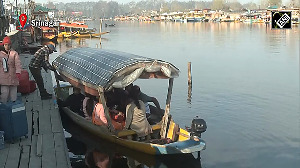The Indian Navy on Friday commissioned its first Unmanned Aerial Reconnaissance Squadron at its Southern Naval base in Kochi.
With this the Indian Navy joined a select band of navies in the world that are equipped with this facility.
Naval Chief Admiral Arun Prakash commissioned navy's new INAS 342 Squadron in the presence of top Naval commanders.
The Naval UAV squadron comprises six Israel-made medium altitude Heron and high-altitude Searcher MK II UAV's, which is likely to sharpen the aerial eye coverage of neighbouring oceans.
"The induction of the UAV platforms will add to the Navy's warfare capability as these would serve as force multipliers in support of fleet operations," a Naval spokesman said.
The Navy's Maritime Aerial reconnaissance capacity had been depleted recently after its Russian acquired IL-38 aircraft crashed and the longer range TU142 was dispatched to Russia for upgradation.
The Navy is also in the process of finalising arrangements with the US Naval authorities for acquiring on lease few Lockheed-Martin P3C Orion aircraft, which may join the force by the end of the next month.
Admiral Prakash said unmanned aerial vehicles represent a number of advanced technologies, small efficient aero-engines, light composite airframes, miniaturised sensor paylods and high-speed digital data-links.
UAVs bring many advantages with them, he said, adding that they are compact, and relatively silent and therefore stealthy. They could be sent in harm's way because no human lives are at risk, and have long endurance and are economical.
UAV's sensors provide continuous information in real time that often surpasses the quality and accuracy of that provided by bigger and more expensive manned aircraft, he said.
Pointing out that Indian Navy was the first to operate UAVs out at sea in a tropical environment, involving heavy rainfall, the Naval chief said, "It took time to gain experience and expertise, but after three years of intensive flying trials, we are now amongst the pioneers in the esoteric art of UAV operation at sea."
"Equipped with the Searcher Mark II and the Heron UAVs, INAS 342, is going to be an asset which will enhance our maritime domain awareness manifold, capable of operating from any shore location, and being controlled from specially equipped ships, these UAVs will undertake reconnaissance hundreds of miles out at sea," Admiral Prakash said.






 © 2025
© 2025